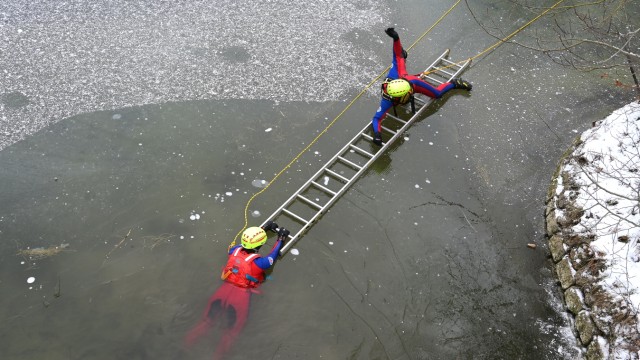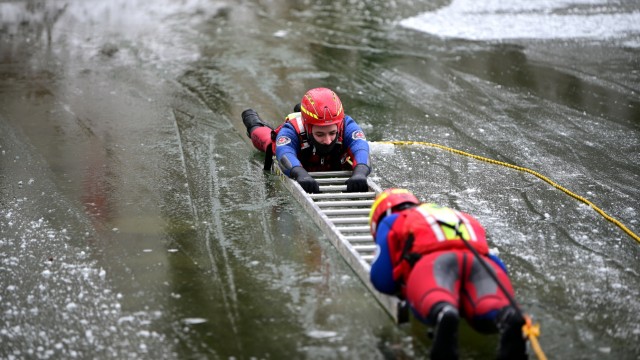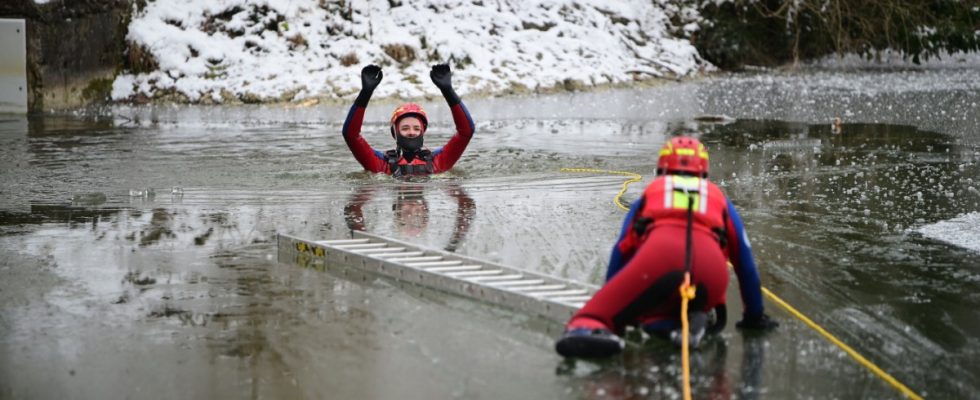The ice cream looks so tempting, sometimes very clear, sometimes milky white. The temperatures on this Saturday afternoon are so frosty at the Floßlände in Thalkirchen that you would like to start walking, on runners or, if necessary, just with shoes. But the idyll is deceptive, the seemingly stable layer of ice on the water begins to crackle when Julia Kaeß ventures out onto the ice surface. Then a crack, a few more steps, and suddenly the ground gives way. She’s lying in the icy water, now we have to move quickly.
A group in red and blue neoprene suits from the Bavarian Red Cross (BRK) is standing on the bank. A so-called throw bag is immediately pulled out, which contains a safety rope about 15 to 20 meters long. This is clicked into the carabiner of Michael Brambach’s impact protection vest, and another rope is attached to the silver rescue ladder.
Course leader Julia Kaeß and her colleagues from the water rescue team train ice rescue on the Floßlände.
(Photo: Robert Haas)

A wave from the rescuer and the colleagues on the bank pull the ladder back.
(Photo: Robert Haas)
Brambach grabs this and runs onto the ice. As he approaches the injured colleague, his steps become cautious. He carries the ladder between his legs. As the ice becomes thinner and thinner, he lies flat on it and pushes himself forward. Julia Kaeß grabs her, a quick wave from the rescuer, and her colleagues on the bank start pulling.
The ladder slides back, pulling the woman out of the water and over the thin ice to safety. Normally, the hypothermic person would now be placed on an emergency blanket, warmed with additional blankets, but not moved or shaken too much so that the cold blood in the limbs does not reach the center of the body and cause damage there. Julia Kaeß, on the other hand, gets up, has her safety rope removed and is now looking for volunteers who can be trained in ice rescue. The trainer and chairwoman of the Isarrettung, as the BRK local association in Munich Mitte calls itself, thinks it is important that her colleagues are also fit in this area of water rescue.
What the rescuers are currently practicing on the raft is life-threatening for civilians. Especially now, when an area of ice forms on the surface of lakes and ponds, the BRK expressly warns against entering frozen water areas without official approval from the city. The ice is currently too thin everywhere in Munich and all lakes are closed. The curling areas on the Nymphenburg Canal are also not in operation. “In the places where the sun shines, the ice is not thick enough,” says operator Herbert Fesl.
Nevertheless, many Munich residents ignore the ice skating ban. Shortly before the BRK group comes over from the theoretical part of ice rescue in the guard house at Marienklause for practical training, a city employee stops briefly in his orange car. He has to ensure that no one steps on the ice here or, for example, at Lake Hinterbrühl and puts their life in danger. The seemingly stable ice and the visitors’ lack of insight forced him to call the police the day before. The police are also supposed to drive past the Nymphenburg Canal from time to time to chase people off the ice.

Anyone who slides too far forward on the ladder endangers themselves and the rescue.
(Photo: Robert Haas)
Julia Kaeß does the opposite, she sends her people out. Always changing, everyone should take the position of the rescuer. It is also corrected when someone in the dangerous area kneels on the ladder instead of lying flat to distribute weight on the thin ice surface. The position on the ladder also plays a role; anyone who slides too far forward endangers themselves and the rescue. The injured person should under no circumstances hold on to the rescuer; if they panic, this could mean the death of both of them.
Before training for an emergency, the group looked for a passage further up the river with thin ice. Everyone should get the feeling of how the ice cracks and creaks, what it feels like to break through. And how unpredictable the ice is. In some places the rescuers have to jump hard to sag. A few meters further it goes very quickly. Susanne Bach-Merkaj, who is doing her ice training, notices how difficult it is to get out again straight away. The ice breaks away on the way back and she has to work really hard to get out of the very shallow water.
The golden rule comes from the trainers: “Always take the same route back.” Because there was one last place there that was sustainable. If someone can’t do it themselves, that means what training manager Kaeß exclaims when her colleagues are practicing. “Person in rescue!” To avoid this, no one should go onto the ice until access is officially permitted. Even if it still looks so inviting these days.

